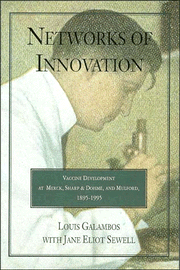Book contents
- Frontmatter
- Contents
- PREFACE
- 1 1894: “The foremost medical question of the day”
- 2 The Mulford Story
- 3 A Sharp & Dohme Interlude
- 4 The Virology Network and a New Program at Merck Sharp & Dohme
- 5 Hilleman's Innovations: First Phase
- 6 Dangerous Interlude
- 7 Transforming Bacteriology: A Second Phase
- 8 New Networks, New Leadership: The Hepatitis B Vaccines
- 9 Vaccine Innovation in the Nineties: New Strategies, New Opportunities, and Public Confrontations
- 10 Historical Perspectives on the Process of Innovation
- ACKNOWLEDGMENTS
- A WORD ABOUT SOURCES
- INDEX
- Plate section
3 - A Sharp & Dohme Interlude
Published online by Cambridge University Press: 06 July 2010
- Frontmatter
- Contents
- PREFACE
- 1 1894: “The foremost medical question of the day”
- 2 The Mulford Story
- 3 A Sharp & Dohme Interlude
- 4 The Virology Network and a New Program at Merck Sharp & Dohme
- 5 Hilleman's Innovations: First Phase
- 6 Dangerous Interlude
- 7 Transforming Bacteriology: A Second Phase
- 8 New Networks, New Leadership: The Hepatitis B Vaccines
- 9 Vaccine Innovation in the Nineties: New Strategies, New Opportunities, and Public Confrontations
- 10 Historical Perspectives on the Process of Innovation
- ACKNOWLEDGMENTS
- A WORD ABOUT SOURCES
- INDEX
- Plate section
Summary
THE BALTIMORE-BASED Sharp & Dohme Company had been looking for a convenient means of moving into biologicals to extend its product line and to develop new capabilities. After the firm was reorganized in 1929, it made an offer to purchase the H. K. Mulford Company. At that time, Sharp & Dohme (S & D) was essentially a manufacturer and distributor of ethical drugs. Since its founding as a Baltimore drug store in 1845, the firm had developed new products, including for instance a “soluble hypodermic tablet” and S.T. 37 (4-hexylresorcinol), an antiseptic solution. But in the late 1920s the company still had a very small research and development organization and had not ventured into the production of biologicals.’ What it had done was build up an extremely effective distribution network, with branch offices in New York, Chicago, Philadelphia, Boston, Atlanta, St. Louis, New Orleans, Kansas City, Dallas, and San Francisco. Lacking an R & D base or relevant production facilities upon which to build a venture into biologicals, Sharp & Dohme purchased those capabilities and looked to its own marketing organization to make the investment profitable.
The investment bankers who guided the reorganization of Sharp & Dohme and the purchase of H. K. Mulford Company quickly consolidated the two firms, bringing in new professional managers to run the business. In this industry as in others, professional managers were the agents of change. They were charged with developing new organizational capabilities that would improve efficiency in the short term and position the company for success in longterm, strategic competition. When they failed, of course, they could be replaced by a new team of managers.
- Type
- Chapter
- Information
- Networks of InnovationVaccine Development at Merck, Sharp and Dohme, and Mulford, 1895–1995, pp. 33 - 52Publisher: Cambridge University PressPrint publication year: 1996



